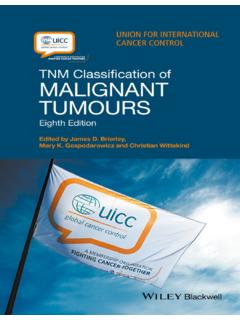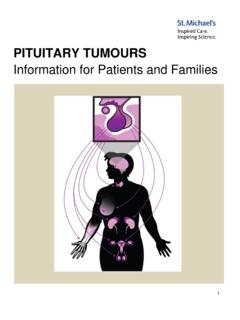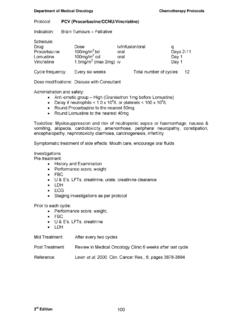Transcription of WHO histological classification of gastric tumours
1 WHO histological classification of gastric tumours1 TNM classification1T Primary TumourTXPrimary tumour cannot be assessedT0No evidence of primary tumourTis Carcinoma in situ: intraepithelial tumour without invasion of the lamina propriaT1 Tumour invades lamina propria or submucosaT2 Tumour invades muscularis propria or subserosa2T3 Tumour penetrates serosa (visceral peritoneum) without invasion of adjacent structures2,3,4,5T4 Tumour invades adjacent structures2,3,4,5N Regional Lymph NodesNXRegional lymph nodes cannot be assessedN0No regional lymph node metastasisN1 Metastasis in 1 to 6 regional lymph nodesN2 Metastasis in 7 to 15 regional lymph nodesN3 Metastasis in more than 15 regional lymph nodesM Distant MetastasisMXDistant metastasis cannot be assessedM0No distant metastasisM1 Distant metastasisStage GroupingStage 0 TisN0M0 Stage IAT1N0M0 Stage IBT1N1M0T2N0M0 Stage IIT1N2M0T2N1M0T3N0M0 Stage IIIAT2N2M0T3N1M0T4N0M0 Stage IIIBT3N2M0 Stage IVT4N1, N2, N3 M0T1, T2.
2 T3 N3M0 Any TAny NM1 TNM classification of gastric tumours38 tumours of the stomachEpithelial tumoursIntraepithelial neoplasia Adenoma8140/02 CarcinomaAdenocarcinoma8140/3intestinal type8144/3diffuse type8145/3 Papillary adenocarcinoma8260/3 Tubular adenocarcinoma8211/3 Mucinous adenocarcinoma8480/3 Signet-ring cell carcinoma8490/3 Adenosquamous carcinoma8560/3 Squamous cell carcinoma8070/3 Small cell carcinoma8041/3 Undifferentiated carcinoma8020/3 OthersCarcinoid (well differentiated endocrine neoplasm)8240/3 Non-epithelial tumoursLeiomyoma8890/0 Schwannoma9560/0 Granular cell tumour9580/0 Glomus tumour8711/0 Leiomyosarcoma8890/3GI stromal tumour8936/1benign8936/0uncertain malignant potential8936/1malignant8936/3 Kaposi sarcoma9140/3 OthersMalignant lymphomasMarginal zone B-cell lymphoma of MALT-type9699/3 Mantle cell lymphoma9673/3 Diffuse large B-cell lymphoma9680/3 OthersSecondary tumours_____1{1, 66}. This classification applies only to help desk for specific questions about the TNM classification is available at tumour may penetrate muscularis propria with extension into the gastrocolic or gastrohepatic ligaments or the greater and lesser omentum without perforation of the visceral peri-toneum covering these structures.
3 In this case, the tumour is classified as T2. If there is perforation of the visceral peritoneum covering the gastric ligaments or omenta, the tumouris classified as adjacent structures of the stomach are the spleen, transverse colon, liver, diaphragm, pancreas, abdominal wall, adrenal gland, kidney, small intestine, and extension to the duodenum or oesophagus is classified by the depth of greatest invasion in any of these sites including classification is modified from the previous WHO histological classification of tumours {2066} taking into account changes in our understanding of these lesions. In the case ofendocrine neoplasms, the classification is based on the recent WHO clinicopathological classification {1784}, but has been simplified to be of more practical utility in code of the International classification of Diseases for Oncology (ICD-O) {542} and the Systematized Nomenclature of Medicine ( ). Behaviour is coded/0 for benign tumours , /3 for malignant tumours , and /1 for unspecified, borderline or uncertain behaviour.
4 Intraepithelial neoplasia does not have a generic code in ICD-O. ICD-O codesare available only for lesions categorized as glandular intraepithelial neoplaia grade III (8148/2), and adenocarcinoma in situ (8140/2).03 7:41 Page 38


